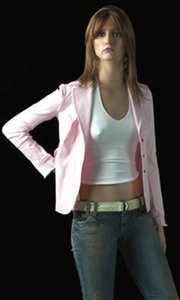L.A. Company Makes Visual Display a Moving Experience
Woody Lawhon has spent close to two decades doing special effects for the movie industry, specializing in animatronics, the creation of moving electronic replicas of actors and animals. Now, he’s applying his expertise, along with some technology enhancements, to the visual display sector of the apparel industry.
Lawhon recently launched Los Angeles–based Moving Mannequins, which builds mannequins that can actually move automatically, as well as non-motion pieces. Moving or not, the product is a departure from the industry norm, Lawhon said.
Over the past three years, Lawhon has assembled a team of craftsmen, sculptors, finishing artists and quality controllers to create mannequins that feature prosthetic eyes and “skin” decorated with seven layers of paint. Lawhon said the results are the most lifelike features ever seen on mannequins.
“We’ve studied the history of mannequins. They’ve been around for 200 years, but there has not been a lot of change,” he said. “We felt there was a hole in the industry.”
Lawhon’s mannequins currently have limited movements. “They can turn their heads and look at you,” he explained, adding that he plans to take it a step farther.
The mannequins are powered with electricity, and their movement is activated by a controller card built inside the figures.
“We envision stores creating Norman Rockwell scenes in their windows, where the mannequins can interact with each other,” Lawhon said.
The mannequins are made of a urethane composite. Their hairpieces are interchangeable as are their prosthetic eyes. The work of the company’s artists puts the finishing touches on the reproductions, according to Lawhon. “When you use the different layers of paint that we do, they bleed together so you create a translucence and realistic skin look,” he said.
The mannequins are priced from $1,400 to $1,900 and are made to order. The turnaround time is about eight weeks. Companies can order exact replicas of their fit models or of celebrities—if they have the legal right to do so.
Lawhon had the idea to bring animatronics to the fashion industry years ago. He had been contracted to do a figure for a fashion customer and even before that saw something was missing in visual display for retailers and designers. “Taking what was a static environment and adding lifelike features and motion in regards to head turn seemed to be a logical next step,” he said.
Visual display is not the only possibility for the mannequins. The next phase for Moving Mannequins will be to develop storefront mannequins that are exact replicas of the models being utilized for designers’ specific television and print advertising campaigns.
The company has so far placed the mannequins with retailers on the Third Street Promenade in Santa Monica, Calif., and at Universal CityWalk in Los Angeles.
For more information, visit www.movingmannequins.com, or call (877) 405-3500. —Robert McAllister






















